-
Countries
-
Data and Analysis
-
Special Focus
-
Crisis Responses
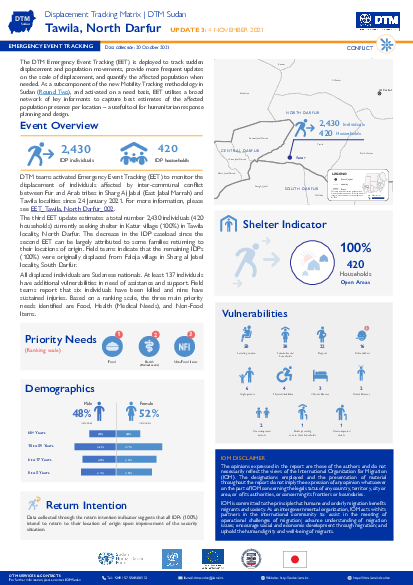
Contact
DTM Sudan; dtmsudan@iom.int
Language
English
Location
Sudan
Snapshot Date
Oct 20 2021
Activity
- Event Tracking
- Mobility Tracking
The DTM Emergency Event Tracking (EET) is deployed to track sudden displacement and population movements, provide more frequent updates on the scale of displacement, and quantify the affected population when needed. As a subcomponent of the new Mobility Tracking methodology in Sudan (Round Two), and activated on a need basis, EET utilises a broad network of key informants to capture best estimates of the affected population presence per location – a useful tool for humanitarian response planning and design.
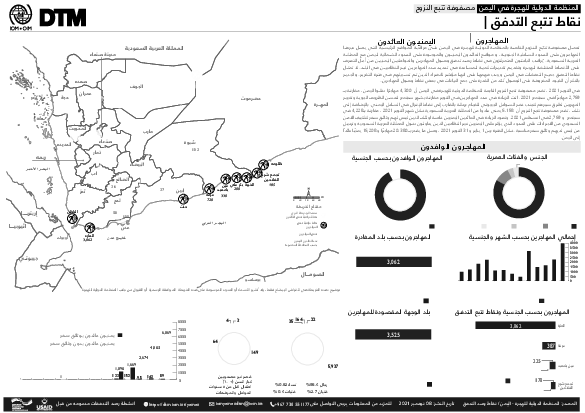
Contact
IOM DTM Yemen, iomyemendtm@iom.int
Language
Arabic
Location
Yemen
Period Covered
Oct 01 2021
Oct 31 2021
Activity
- Flow Monitoring
تعمل مصفوفة تتبُع النزوح الخاصة بالمنظمة الدولية للهجرة في اليمن على مراقبة المواقع الرئيسية التي يصل عبرها المهاجرون على الحدود الساحلية الجنوبية، و مواقع العائدون اليمنيون والموجودة على الحدود الشمالية لليمن مع المملكة العربية السعودية. يُراقب الباحثون المتمركزون في نقاط رصد تدفق وصول المهاجرين والمواطنين اليمنيين من أجل التعرف على الأنماط المختلفة للهجرة وتقديم تقديرات كمية للمساعدة في تحديد عدد المهاجرين غير النظاميين في البلد. لا تمثل نقاط التدفق جميع التدفقات في اليمن ويجب فهمها على انها مؤشر للافراد الذين تم تسجيلهم في فترة التقرير. والجدير بالذكر أن القيود المفروضة على الوصول تَحُد من القدرة على جمع البيانات في بعض نقاط وصول المهاجرين.
في اكتوبر 2021 ، تقدر مصفوفة تتبع النزوح التابعة للمنظمة الدولية للهجرة في اليمن أن 4,300 مهاجرًا دخلوا اليمن ، مقارنة بـ 2,769 مهاجرًا في سبتمبر 2021. اتت الزيادة في عدد المهاجرين في اكتوبر مقارنة بشهر سبتمبر لتحسن الظروف الجوية وتغيير المهربين لطرق سيرهم لتجنب خفر السواحل الجيبوتي للقيام برحلة بالقارب إلى نقاط الإنزال في الساحل اليمني. حيث مثل عدد المهاجرين من إثيوبيا 92 في المائة و ثمانية في المائة من الصوماليين. كانت غالبية المهاجرين من الذكور (83 ٪) ، مع تسعة في المائة من النساء ، و اربعة في المائة من الأولاد و اربعة في المائة من الفتيات اللواتي كنا ايضاً من ضمن المسافرين.بالإضافة إلى ذلك ، تقدر مصفوفة تتبع النزوح أن 6،158 يمني عادوا من المملكة العربية السعودية خلال شهر اكتوبر 2021 ، مقارنة بـ4,228 في سبتمبر و 2,769 في اغسطس 2021. وتعود الزيادة في العائدين اليمنيين خاصة اولئك الذين ليس لهم وثائق سفر لتكثيف الامن السعودي من الاجراءات على الحدود الذي يؤثر على اليمنيين غير النظامين الذين يحاولون دخول الممكلة العربية السعوديه وترحيل من ليس لديهم وثائق سفر مناسبة. خلال الفترة بين 1 يناير و 31 اكتوبر 2021 ، وصل ما يقدر بـ 20،380 مهاجرًا و 16,208 يمنيًا عائداً إلى اليمن.
خلال فترة التقرير في اكتوبر 2021، شوهد وصول 1,238 مهاجرا من الصومال وتم تسجيلهم في نقاط مراقبة التدفق في محافظتي ضبوة وحضرموت حيث سجل في عرقة 720 ؛ و 330 في عين بامعبد ؛ و 185 تم تسجيلهم في نقطة مراقبة التدفق تجمع شرج الفلاجين. بينما شهدت نقطة مراقبة التدفق في العارة بمحافظة لحج أكبر عدد من الوافدين ، حيث وصل 3,062 مهاجراً من جيبوتي.
المنهجيــة:
تهدف منهجية تتبع النزوح العالمية إلى التعرف على المناطق التي تحدث فيها الهجرة الداخلية والهجرة العابرة للحدود والهجرة الإقليمية. وتُنَفَذّ تقييمات التنقل للمناطق على المستوى الوطني. ومن ثم تقوم فرق مصفوفة التتبع بجمع المعلومات على المستوى المحلي للتعرف على نقاط العبور الرئيسية. يجمع الباحثون الميدانيون البيانات من مُدلين رئيسين بالمعلومات في نقاط رصد التدفق: ويمكن للمُدلين الرئيسيين ان يكونوا افرادً يعملون في النقل او موظفون في الجمارك او افرادً يعملون في قوارب او المهاجرون انفسهم. تُجمع البيانات باستخدام استمارة بسيطة و بالملاحظة المباشرة وهو ما يُسَهل عملية التحليل.
القيــــــود:
يجب تفسير البيانات المستخدمة في هذه العمليات كتقديراتً فقط، وانها تمثل فقط جزءاً من اجمالي التدفق الذي يمر عبر اليمن. ولذلك، ان التغطية الزمنية والمساحية غير مكتملة. وبالإضافة إلى ذلك، بالرغم من ان البيانات تُجمع بشكل يومي، إلا انها تُجمع فقط خلال ساعات الذروة. وإن نسبة التدفقات التي تحدث في الساعات التي لم تتم تغطيتها، لا تُمَثَل هنا. أما البيانات المتعلقة بالضُعف فهي ترتكز على الملاحظة المباشرة ويجب ان تفُهم بصفتها بيانات دلالية في المقام الأول.
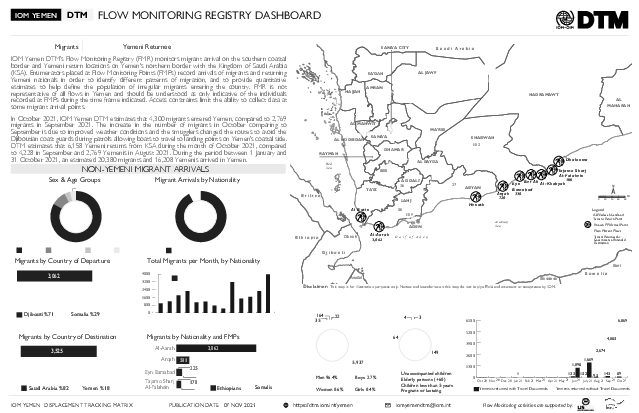
Contact
IOM DTM Yemen, iomyemendtm@iom.int
Language
English
Location
Yemen
Period Covered
Oct 01 2021
Oct 30 2021
Activity
- Flow Monitoring
In October 2021, IOM Yemen DTM estimates that 4,300 migrants entered Yemen, compared to 2,769 migrants in September 2021. The increase in the number of migrants in October comparing to September is due to improved weather conditions and the smugglers changed the routes to avoid the Djiboutian coast guards during patrols allowing boats to travel to landing points on Yemen’s coastal side. DTM estimates that 6,158 Yemeni returns from KSA during the month of October 2021, compared to 4,228 in September and 2,769 Yemenis in August 2021. During the period between 1 January and 31 October 2021, an estimated 20,380 migrants and 16,208 Yemenis arrived in Yemen.
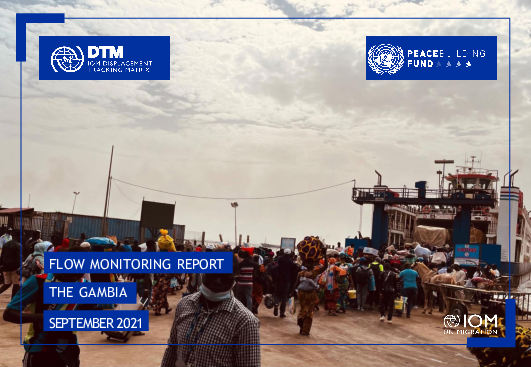
Contact
Regional Office, rodakar-dataresearch@iom.int
Language
English
Location
The Gambia
Period Covered
Sep 01 2021
Sep 30 2021
Activity
- Flow Monitoring
Flow Monitoring activities are conducted in close cooperation with national and local authorities as well as local partners. The Flow Monitoring tool consists of two main components: the Flow Monitoring Registry (FMR), which captures key data on the magnitude, provenance, destination and mode of travel of mobility flows, and the Flow Monitoring Survey (FMS), individual surveys conducted with travellers to gather detailed information about the profiles, migration experience and intentions of migrants.
In The Gambia, DTM conducts Flow Monitoring activities at several important transit locations. This report presents Flow Monitoring Registry data collected from the 1st to the 30th of September 2021 excluding weekends. It presents key data on flows, routes, provenance, destination and demographic profiles of travellers observed at the FMPs.

Contact
DTM Colombia, DTMColombia@iom.int
Language
Spanish
Location
Colombia
Period Covered
Oct 01 2021
Oct 30 2021
Activity
- Flow Monitoring
El 89% de los nacionales venezolanos entrevistados (as) durante el mes de octubre indican que proceden de Venezuela, destacándose que el 14% provienen de Distrito Capital, 12% de Carabobo y 10% de Aragua. En una proporción menor provienen de otros países como: Perú (5%) y Ecuador (4%).
IOM works with national and local authorities in order to gain a better understanding of population movements throughout Southern Africa. Through the setup of Flow Monitoring Points (FMPs), IOM seeks to quantify migration flows, trends and routes and to gain a better understanding of the profiles of observed individuals at entry, transit or exit points (such as border crossing posts, bus stations, rest areas, police checkpoints and reception centres). This report is an overview of the data collected in these FMPs from 1 to 31 October 2021.
Inter-regional migration from and within the Southern Africa is categorized along the following corridors. The Flow Monitoring Points (FMPs) were set-up in several key transit locations along the corridors to track the movements of passengers:
•Zimbabwe (Mutare) – Mozambique (Manica)
•Zimbabwe – Zambia (Chirundu)
•Zimbabwe – Botswana (Plumtree)
•Zimbabwe (Beitbridge) – South Africa
•Malawi (Mchinji) – Zambia (Mwami)
•Malawi (Karonga) – Tanzania
•Malawi (Mwanza) – Mozambique (Zobue)
During October 2021, a total of 53,640 movements were observed across 29 FMPs in the region.
The Zimbabwe (Beitbridge) – South Africa corridor hosted the largest number of movements with 21,070 (39%) followed by the Mozambique Malawi corridor with 19,201 (36%) and the Malawi – Zambia corridor with 5,877 movements reported (11%).
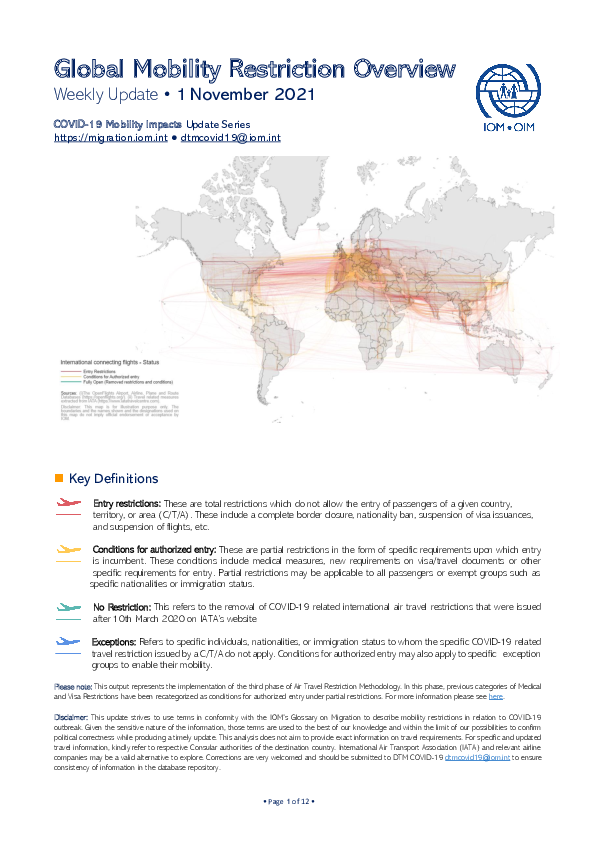
Contact
DTMcovid19@iom.int
Language
English
Location
Global
Snapshot Date
Nov 01 2021
Activity
- Other
The current outbreak of COVID-19 has affected global mobility in the form of various travel disruptions and restrictions. To better understand how COVID-19 affects global mobility, DTM has developed a COVID-19 database mapping the different restrictions to provide a global overview. For this, DTM uses the IATA site as the primary source of restrictions with the information reported per country and territory, and to the country of application.
Data collected includes:
- Date of restriction
- Country, territory or area of restriction
- Countries, territories or areas on which restrictions were imposed
- Type of restriction- total restriction, or conditional restriction – such as medical/ and or visa restriction
This DTM COVID-19 Travel Restrictions Output presents an analysis based on country imposing, the country being imposed upon, and the aggregation of the restriction type. The aim of the data analysis is to provide an overview of the COVID-19 outbreak on global mobility and to help identify and develop responses.
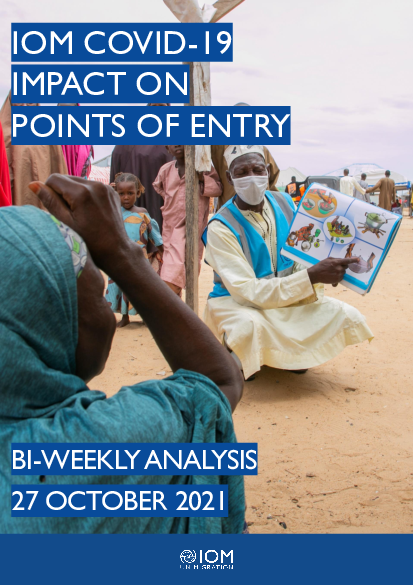
Contact
DTMcovid19@iom.int
Language
English
Location
Global
Period Covered
Mar 13 2020
Oct 21 2021
Activity
- Mobility Tracking
- Points of Entry (PoE)
IOM COVID-19 Impact on Points of Entry Bi-Weekly Analysis is meant to serve IOM Member States, IOM, UN and voluntary partner agencies, the civil society (including media) as well as the general population in analysing the impact of COVID-19 pandemic on Points of Entry. It is particularly relevant when identifying and addressing specific needs faced by migrants and mobile populations, disproportionately affected by global mobility restrictions. The report is based on information provided by IOM field staff, using resources available at the IOM country office level and is accurate to the best of IOM’s knowledge at the time of compilation. All information is being constantly validated, including the geolocation and attributes, and through regular assessments and triangulation of information. The updates depend on the time frame within which the information becomes available and is processed by IOM. For this reason, the analysis is always dated and timestamped in order to reflect reality at a given time. However, as the situation continuously evolves and changes, despite IOM’s best efforts, the analysis may not always accurately reflect the multiple and simultaneous restrictive measures being imposed at a specific location.
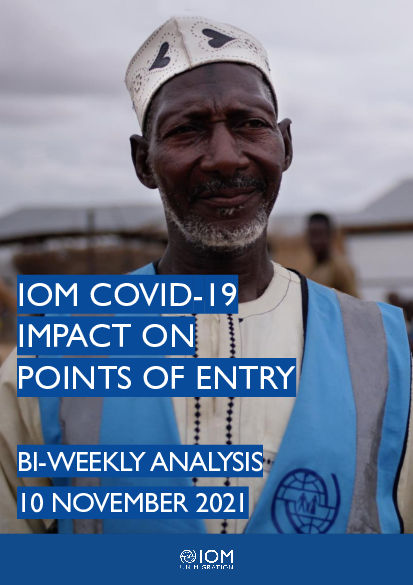
Contact
DTMcovid19@iom.int
Language
English
Location
Global
Period Covered
Mar 13 2020
Nov 04 2021
Activity
- Mobility Tracking
- Points of Entry (PoE)
IOM COVID-19 Impact on Points of Entry Bi-Weekly Analysis is meant to serve IOM Member States, IOM, UN and voluntary partner agencies, the civil society (including media) as well as the general population in analysing the impact of COVID-19 pandemic on Points of Entry. It is particularly relevant when identifying and addressing specific needs faced by migrants and mobile populations, disproportionately affected by global mobility restrictions. The report is based on information provided by IOM field staff, using resources available at the IOM country office level and is accurate to the best of IOM’s knowledge at the time of compilation. All information is being constantly validated, including the geolocation and attributes, and through regular assessments and triangulation of information. The updates depend on the time frame within which the information becomes available and is processed by IOM. For this reason, the analysis is always dated and timestamped in order to reflect reality at a given time. However, as the situation continuously evolves and changes, despite IOM’s best efforts, the analysis may not always accurately reflect the multiple and simultaneous restrictive measures being imposed at a specific location.

Contact
DTM Turkey, dtmturkey@iom.int
Language
English
Location
Republic of Türkiye
Period Covered
Oct 01 2021
Oct 31 2021
Activity
- Flow Monitoring Survey
- Flow Monitoring
- Migrants presence
- Mobility Tracking
According to the latest available figures from the Turkish Directorate General of Migration Management (DGMM), there are more than 4.9* million foreign nationals present in Turkish territory, 3.7* million of whom are seeking international protection.
Most of those seeking international protection are Syrians (3,726,206* individuals) who are granted the temporary protection status in Turkey.
In addition, international protection applicants are most frequently nationals of Afghanistan, the Islamic Republic of Iran and Iraq constitute another group of foreign nationals. According to DGMM, there were 31,334* international protection applicants present in Turkey in 20201, published annually. Moreover, according to UNHCR**, there are close to 330,000 international protection status holders and asylum seekers. In addition, there are 1,241,844* foreign nationals under residence permit holder status; this number includes humanitarian residence holders.
*Data Source DGMM, 28.10.2021
**Data source UNHCR, September 2021

